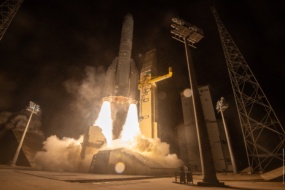After the FCC delivered the final seal of approval last week, European satellite pioneer SES completed its acquisition of US competitor Intelsat, creating a geostationary giant that looks to thrive in a new era of satcom consolidation.
Though the merger puts SES on firmer financial ground, it doesn’t solve the problem of how to compete with SpaceX’s Starlink and other LEO networks.
SpaceX’s growing power is proven by how easily the SES-Intelsat merger won regulatory approval, compared to the heavily scrutinized major satcom consolidation between Inmarsat and Viasat in 2023.
“That’s indicative how much regulators have taken onboard the competition from Starlink, and the effect it is having on the market,” industry analyst Tim Farrar told Payload.
Shore up the walls: SES and Intelsat together had more than $4B in debt at the end of last year, versus a combined revenue projection of $4.3B this year. The new firm says it plans to cut $430M of annual costs thanks to streamlined operations and the purchasing power of the combination. If the deleveraging goes as planned, the company said it would increase its dividend in the next 18 to 24 months.
As part of the acquisition, SES hinted at a strategy of diversifying its offering by exploring new tech in IoT, direct-to-device comms, intersatellite relay, SSA, and quantum key distribution.
“There’s a real need [for SES] to find future areas of growth. And so for them to have this consolidated capex, [that] they don’t have to spend smaller amounts on potentially duplicated [non-recurring engineering], is an advantage,” Caleb Henry, Quilty Space’s director of research, told Payload.
SES and Intelsat both have a history of buying, not building, new tech. So the future may involve more M&A activity as SES expands its capabilities.
C is for wildcard: Investors in the firm are also betting on a reallocation of C-band users in the years ahead. In 2020, the FCC auctioned off a chunk of that spectrum to support the buildout of 5G networks; Intelsat and SES netted more than $5B together for relinquishing their spectrum.
Now, the FCC is discussing another auction. While SES forecasts gaining $500M in such a process (and paying 40% of that to former Intelsat shareholders), Farrar says the potential pay-out from an auction could reach billions of dollars.
That’s good for SES—but it also says something that one of its biggest revenue opportunities is exiting a large chunk of its business.
Starfleet: The firm now boasts the world’s largest commercial geostationary network, including some 90 spacecraft and 30 satellites in MEO, as well as an extensive ground station network.
“To put it into perspective, the average number of GEO satellites owned by your other players is anywhere from 10 to 30,” Henry said.
Those assets position SES to compete across satcom verticals, but what about LEO? Growth may be hard to come by—in one regulatory filing, the company forecast that its NGSO rivals would capture 80% of cellular backhaul service in the years ahead.
Intelsat has invested in Eutelsat to access capacity on the OneWeb constellation, and SES resells Starlink access, but the chance for the new SES to enter that orbit may come through the EU’s still uncertain IRIS2 initiative.
The price is right? The new SES, which forecasts $1B in free cash flow by 2028, is valued by public investors at $3.3B. AST SpaceMobile, its younger rival that is still working to build enough spacecraft to generate cash flow, is valued at $19B. A good growth story is a very valuable thing…




